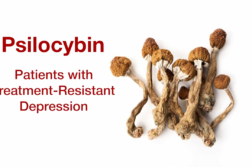INDIANAPOLIS, Ind. (Ivanhoe Newswire) – Millions of people live with chronic pain. The CDC says it affects about 21 percent of adults in the U.S. Doctors say people who have chronic pain are also at higher risk for depression or anxiety. We’ll explain how these debilitating conditions are connected.
Chronic pain and depression are among the most disabling conditions worldwide. Many people struggle with both.
“About half the people with depression have some pain symptoms, and about half the people with pain have some depression symptoms,” says Research Scientist at Regenstrief Institute, Kurt Kroenke, MD.
This can cause a vicious cycle. For example, people dealing with pain often don’t sleep well, which affects their mood, which can make them vulnerable to depression or anxiety, which can then, increase a person’s susceptibility to pain.
Dr. Kroenke adds, “Anybody who’s suffered from chronic pain knows that it just takes over, and the same with depression.”
Dr. Kroenke says when someone visits a doctor for chronic pain, it’s important for the patient to discuss any psychological symptoms they’re also experiencing, like trouble sleeping, no energy, or trouble concentrating.
Dr. Kroenke is the creator of several widely used questionnaires that help doctors easily measure severity of pain, depression or anxiety.
“So, this is a way of saying, you know, ‘Your blood pressure’s up, except your depression score is up.’,” Dr. Kroenke explains.
He says it’s important to identify and treat both to end the negative cycle. When someone is dealing with both pain and depression, treating one can sometimes help lower symptoms of the other. in other cases, a combination of treatments might be needed.
Contributors to this news report include: Lindsay Dailey, Producer; Kyle Fisher, Videographer; Roque Correa, Editor.
To receive a free weekly e-mail on medical breakthroughs from Ivanhoe, sign up at: http://www.ivanhoe.com/ftk
Sources:
https://www.apa.org/depression-guideline/patient-health-questionnaire.pdf
MEDICAL BREAKTHROUGHS
RESEARCH SUMMARY
TITLE: THE LINK BETWEEN CHRONIC PAIN AND DEPRESSION
REPORT: MB #5389
BACKGROUND: Most types of pain eventually subside. For instance, you bounce back after a surgical procedure, your toothache gets treated, your sprained ankle gradually gets better, and the occasional headache can be remedied with aspirin. These are examples of acute, or temporary, pain. However, chronic pain is a type of pain that persists for three months or longer and doesn’t go away easily. The CDC says it affects about 21 percent of adults in the US and is also linked to depression.
(Source: https://www.cdc.gov/mmwr/volumes/72/wr/mm7215a1.htm#:~:text=During%202021%2C%20an%20estimated%2020.9,Hispanic%20American%20Indian%20or%20Alaska , https://www.asahq.org/madeforthismoment/pain-management/types-of-pain/chronic/)
DIAGNOSING: Chronic pain can have various causes. Injuries and diseases can also cause changes in your body that result in increased sensitivity to pain. These changes can persist even after you have healed from the original injury or illness. Additionally, some people experience chronic pain that is not associated with any physical injury or illness. Healthcare providers refer to this as psychogenic pain or psychosomatic pain, which is caused by psychological factors such as stress, anxiety, and depression. Scientists believe that this connection is due to low levels of endorphins in the blood. It is possible to have multiple causes of pain that overlap, such as having two different diseases or experiencing migraines and psychogenic pain together.
(Source: https://www.webmd.com/interaction-checker/default.htm)
TREATMENT: The Patient Health Questionnaire (PHQ) is a diagnostic tool that helps identify common mental disorders. The PHQ-9, which is the depression module, assesses each of the 9 DSM-IV criteria on a scale of “0” (not at all) to “3” (nearly every day). Over 6,000 patients in eight primary care clinics and seven obstetrics-gynecology clinics completed the PHQ-9. The study found that as PHQ-9 depression severity increased, patients experienced a significant decrease in functional status on all six SF-20 subscales. A PHQ-9 score > or =10 had a sensitivity of 88% and a specificity of 88% for major depression, when using the MHP reinterview as the criterion standard. PHQ-9 scores of 5, 10, 15, and 20 represented mild, moderate, moderately severe, and severe depression, respectively. The results were consistent in both primary care and obstetrics-gynecology samples. Apart from its ability to diagnose depressive disorders, the PHQ-9 is also a reliable and valid measure of depression severity.
(Source: https://pubmed.ncbi.nlm.nih.gov/11556941/)
FOR MORE INFORMATION ON THIS REPORT, PLEASE CONTACT:
Regenstrief Institute PR Team
If this story or any other Ivanhoe story has impacted your life or prompted you or someone you know to seek or change treatments, please let us know by contacting Marjorie Bekaert Thomas at mthomas@ivanhoe.com




